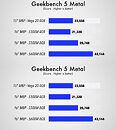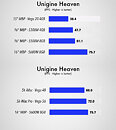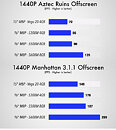Thursday, June 18th 2020

AMD Radeon Pro 5600M with HBM2 Benchmarked
Benchmarks of the new Apple-exclusive AMD Radeon Pro 5600M graphics solution by Max Tech reveals that the new GPU is about 50% faster than the Radeon Pro 5500M, and within striking distance of the Radeon Pro Vega 48 found in Apple's 5K iMacs. The Pro 5600M is an Apple-exclusive solution by AMD, based on the "Navi 12" silicon that features a 7 nm GPU die based on the RDNA graphics architecture, flanked by two 4 GB HBM2 memory stacks over a 2048-bit interface. The GPU die features 2,560 stream processors, but clocked differently from Radeon Pro discrete graphics cards based on the "Navi 10" ASIC that uses conventional GDDR6.
The Radeon Pro 5600M solution was found to be 50.1 percent faster than the Radeon Pro 5500M in Geekbench 5 Metal (another Apple-exclusive SKU found in 16-inch MacBook Pros), and just 12.9 percent behind the Radeon Vega 48. The Vega 56 found in iMac Pro is still ahead. Unigine Heaven sees the Pro 5600M being 48.1% faster than the Pro 5500M, and interestingly, faster than Vega 48 by 11.3%. With 2,560 RDNA stream processors, you'd expect more performance, but this card was designed to meet stringent power limits of 50 W, and has significantly lower clock-speeds than "Navi 10" based Radeon Pro graphics cards (1035 MHz max boost engine clock vs. 1930 MHz and 205 W TDP of the Pro W5700). Find more interesting commentary in the Max Tech video presentation.
Source:
VideoCardz
The Radeon Pro 5600M solution was found to be 50.1 percent faster than the Radeon Pro 5500M in Geekbench 5 Metal (another Apple-exclusive SKU found in 16-inch MacBook Pros), and just 12.9 percent behind the Radeon Vega 48. The Vega 56 found in iMac Pro is still ahead. Unigine Heaven sees the Pro 5600M being 48.1% faster than the Pro 5500M, and interestingly, faster than Vega 48 by 11.3%. With 2,560 RDNA stream processors, you'd expect more performance, but this card was designed to meet stringent power limits of 50 W, and has significantly lower clock-speeds than "Navi 10" based Radeon Pro graphics cards (1035 MHz max boost engine clock vs. 1930 MHz and 205 W TDP of the Pro W5700). Find more interesting commentary in the Max Tech video presentation.



52 Comments on AMD Radeon Pro 5600M with HBM2 Benchmarked
PS: I'm something of an editor myself(previously).
Half the clocks and 1/4th the power budget of the Pro W5700. It's a miracle that this card is doing as well as it is.
All I can see is that a 40CU part is about 50% quicker than the 24CU part , so we know that it's bottlenecked by something other than CUs; Probably power, because it's unlikely to be the HBM2.
With no details on how the test is run or under what conditions, these results are just noise.
As for testing conditions: these are laptops. Beyond controlling ambient temperature and background applications, running them out of the box is the only thing necessary.
nice.
Sure, Wikipedia and TPU will give you 85W as the nominal reference TDP but that's a generic spec which in the case of mobile parts is rarely adhered to by the laptop manufacturer.
In terms of apples-to-apples comparison, we are literally comparing Apple MBP 50W GPUs with the same cooling solution and TDP.
But I was more referring to the tier list in those benches... we're looking at benches that run ancient content and omg look at those fps! In reality though this is just a tiny slice of performance that is realistically available. Bit of a distortion of reality.